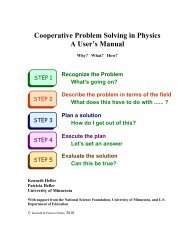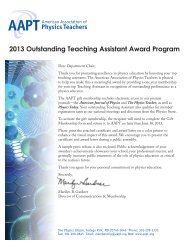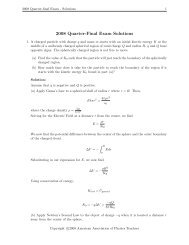Solution - American Association of Physics Teachers
Solution - American Association of Physics Teachers
Solution - American Association of Physics Teachers
Create successful ePaper yourself
Turn your PDF publications into a flip-book with our unique Google optimized e-Paper software.
2013 F = ma Exam 19The following information applies to questions 23 and 24A man with mass m jumps <strong>of</strong>f <strong>of</strong> a high bridge with a bungee cord attached to his ankles. The man falls througha maximum distance H at which point the bungee cord brings him to a momentary rest before he bounces backup. The bungee cord is perfectly elastic, obeying Hooke’s force law with a spring constant k, and stretches froman original length <strong>of</strong> L 0 to a final length L = L 0 + h. The maximum tension in the Bungee cord is four times theweight <strong>of</strong> the man.23. Determine the spring constant k.(A) k = mgh(B) k = 2mgh(C) k = mgH(D) k = 4mgH(E) k = 8mgH24. Find the maximum extension <strong>of</strong> the bungee cord h.(A) h = 1 2 H(B) h = 1 4 H(C) h = 1 5 H(D) h = 2 5 H(E) h = 1 8 H<strong>Solution</strong>At the moment <strong>of</strong> maximum extension, all <strong>of</strong> the gravitational potential energy has been converted to springpotential energy.mgH = 1 2 kh2We are given that the maximum tension in the cord is four times the weight <strong>of</strong> the man; this occurs at themoment <strong>of</strong> maximum extension.kh = 4mgThese can be solved to yieldk = 8mgHh = 1 2 Has well ask = 4mghalthough the latter is not an available answer choice.Copyright c○2013 <strong>American</strong> <strong>Association</strong> <strong>of</strong> <strong>Physics</strong> <strong>Teachers</strong>
















